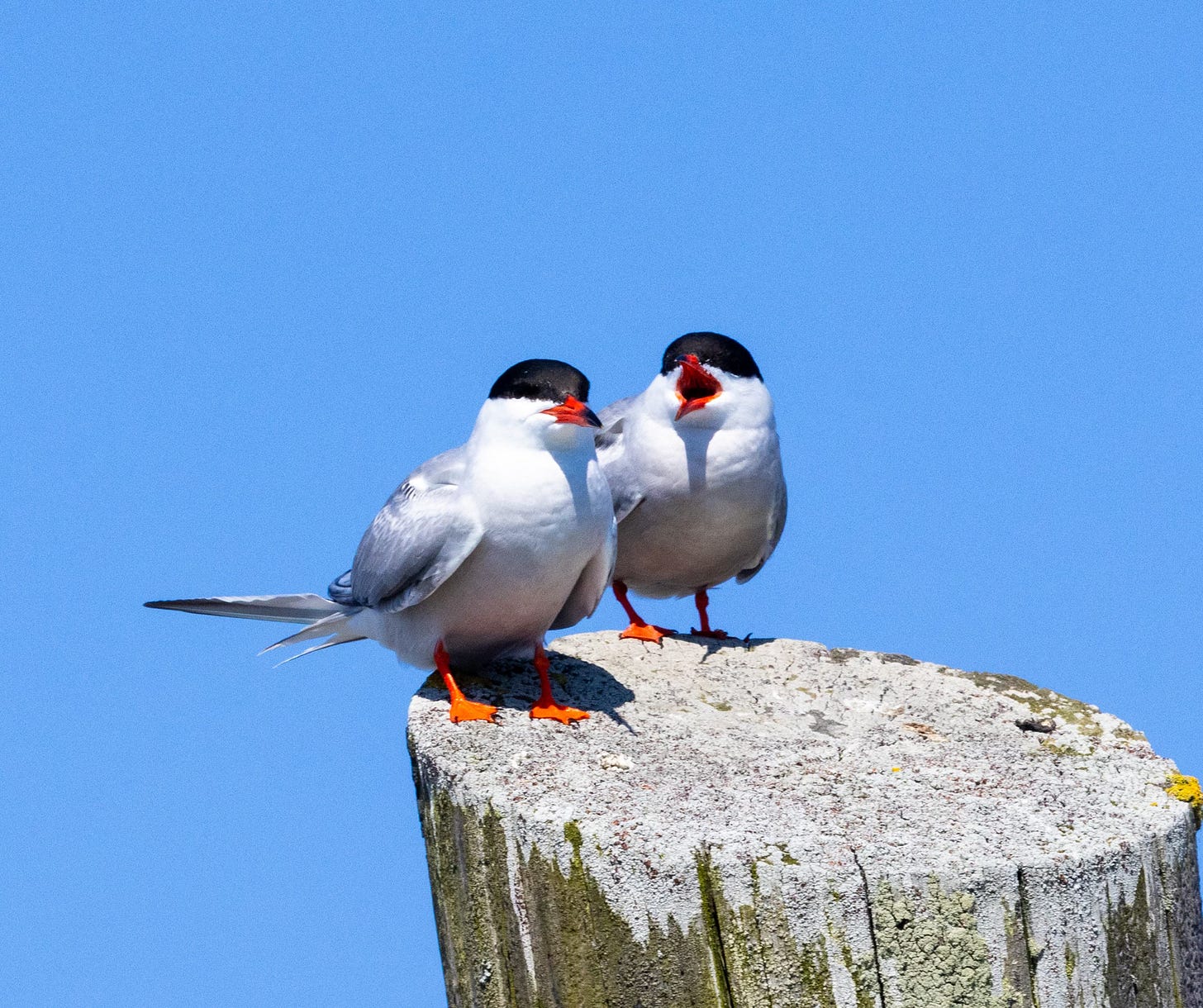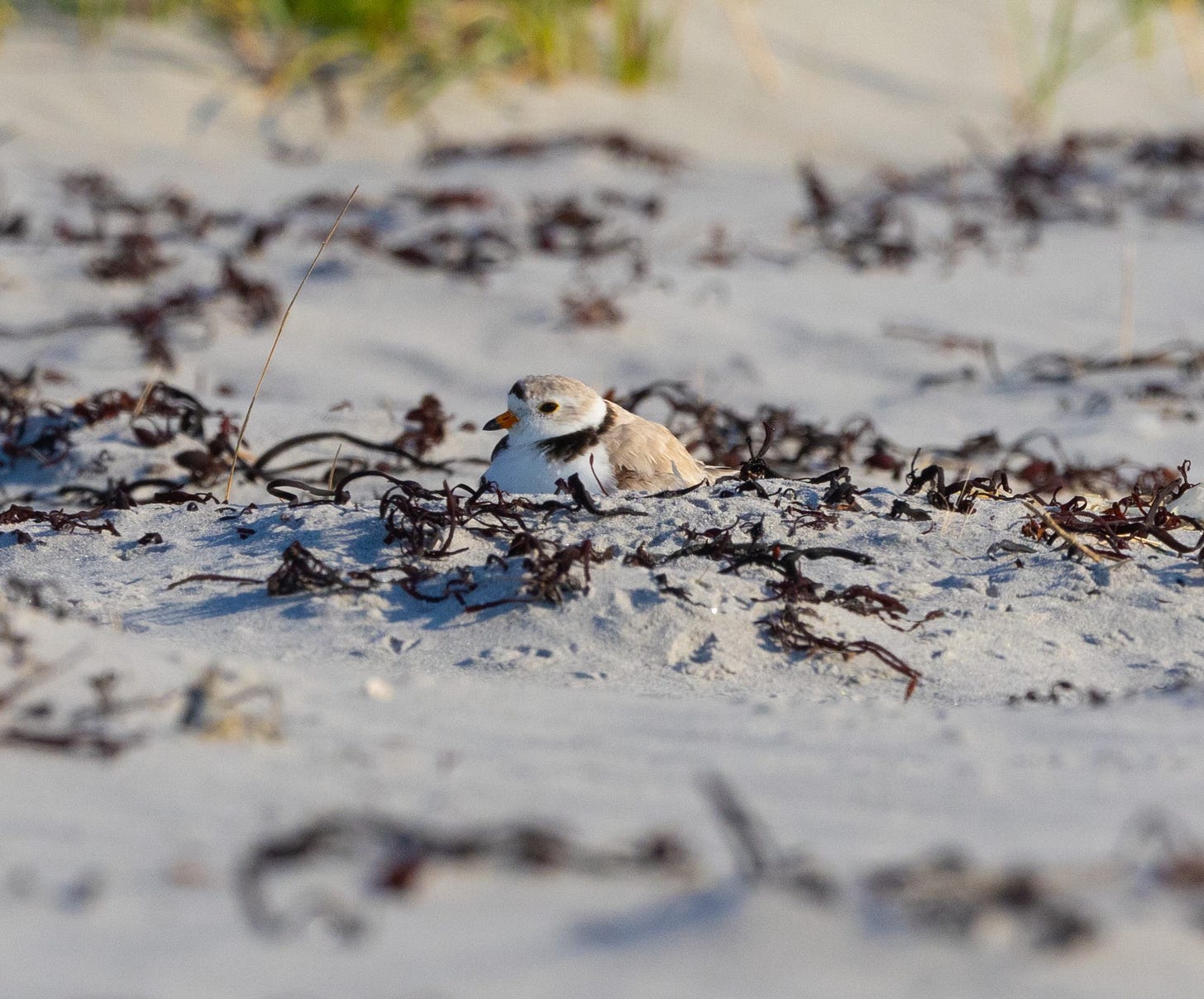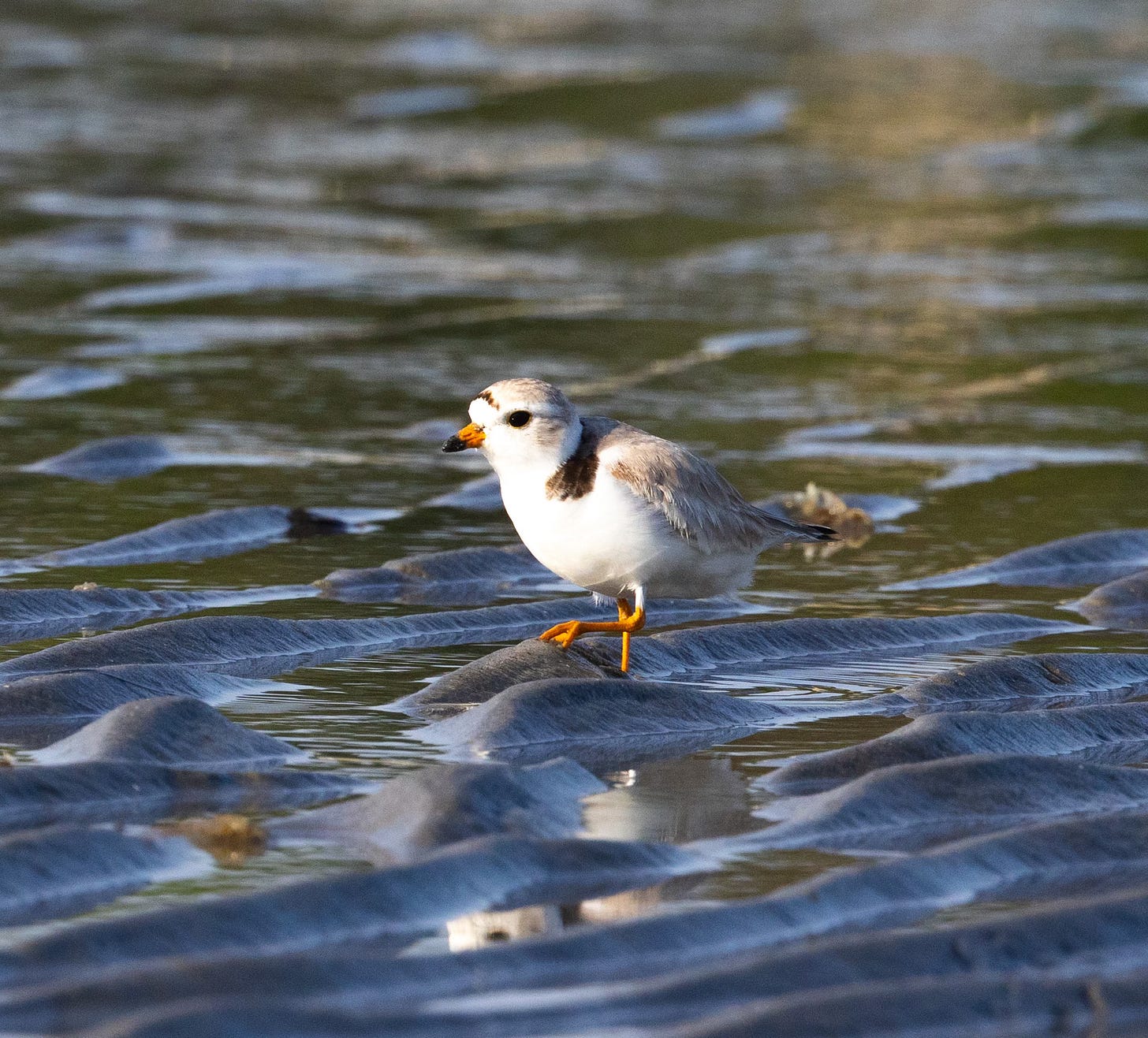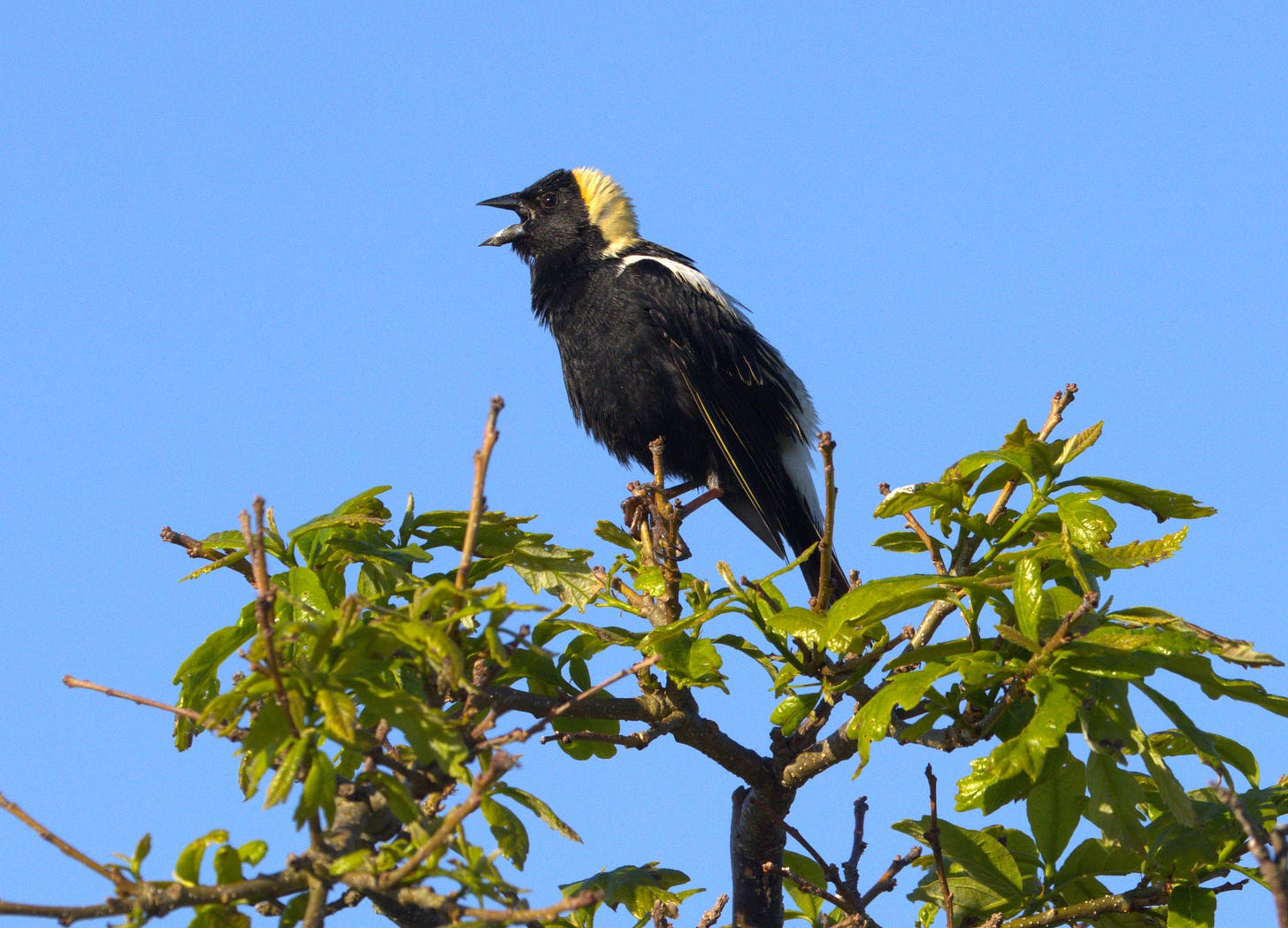1. Let’s begin with “Giga-geese” - meet the Genyornis Newtoni from 45,000 years ago: Australia’s prehistoric thunder birds – once thought to be the ancestors of emus – were, in fact, the biggest geese that ever lived. The group has been reclassified following the analysis of a 45,000-year-old Genyornis newtoni skull found in a fossil deposit at Lake Callabonna in the South Australian desert. The newly discovered skull is the first from the extinct species found since 1913 and the only one preserved well enough to allow detailed anatomical study. It is thought that G. newtoni weighed about 230 kilograms and stood over 2.5 metres tall. However, its close relative, Dromornis stirtoni, reached heights well over 3 metres and weighed up to 600 kilograms, making it not just a contender for biggest bird ever, but by far the largest goose. (via New Scientist)
2. Fun story on life at Rowe Sanctuary on the Platte River during the Sandhill Crane migration: Although I’ve been a birder for nearly two decades, nothing had prepared me for experiencing a Sandhill Crane migration along Nebraska’s Platte River, one of the largest wildlife migrations on Earth. But there I was, trying to take in the sound of intense bugle calls and countless feathers flapping, combined with the sight of flock after flock of cranes flying overhead and crane dances and fights unfolding on the river. Within minutes of watching my first sunset against a backdrop of cranes, I knew that photos and videos were just a small taste of what it feels like being within feet of this incredible migration. (via Audubon)
By Hap Ellis, Common Terns - Cape Porpoise Harbor, Kennebunkport. ME
3. “We’re pulling away the veil across the mystery of this species”. The bird is the little bush moa and the study’s senior author is BNI great favorite Scott Edwards, curator of ornithology at Harvard’s Museum of Comparative Zoology: Using ancient DNA extracted from the toe bone of a museum specimen, Harvard biologists have sequenced the genome of an extinct, flightless bird called the little bush moa, shedding light on an unknown corner of avian genetic history. Published in Science Advances, the work is the first complete genetic map of the turkey-sized bird whose distant living cousins include the ostrich, emu, and kiwi. It is one of nine known species of moa, all extinct for the last 700 years, which inhabited New Zealand before the late 1200s and the arrival of Polynesian human settlers. (via The Harvard Gazette)
4. Bird/glass collisions - worse than we’ve thought says this new study: For the last half century, Daniel Klem, Sarkis Acopian Professor of Ornithology and director of Muhlenberg’s Acopian Center for Ornithology, has been at the forefront of research on bird collisions with glass. His latest peer-reviewed study, with co-authors Ornithological Specialist Peter G. Saenger and former student researcher Brandon P. Brogle '20, shows bird deaths from window strikes are nearly double previous estimates. The following excerpts are from the June 5 National Geographic article “This invisible killer takes out 3.5 billion U.S. birds a year.” Subscribers can access the full article via the link. (via Muhlenberg College)
5. So sad - birding in the valley of Ein Qiniya, northwest of Ramallah: Sitting in the shade of an olive tree in the valley of Ein Qiniya, north-west of Ramallah, the wildlife photographer and birdwatcher Mohamad Shuaibi starts to enumerate the birds he can spot. Swifts and swallows flit and swoop, a short-toed eagle hovers in the distance, a jay perches on an olive branch and a kestrel returns to its nest in the limestone cliffs. He also starts counting the times he has been stopped by Israeli soldiers or police out in the field with his camera. “I was detained four times already since October, and each time was worse,” he says. He now avoids going out at certain times: “To watch birds we need to go out very early in the morning. But most of the military operations are in the early hours, so you can be shot if you’re out around this time.” Spring sees millions of birds fly over the occupied territories of Palestine, part of the world’s second-busiest corridor for bird migration. (via The Guardian)
6. BNI pulling for the Western Sandpipers!: This is the story of a mud wrestle at the Fraser River delta. On one side, a government proposal for a massive expansion of a container port. On the other, a tiny bird, the sandpiper, which relies on this place as its last stopover on a migration as long as 7,000 miles. Then there’s the mud itself, the prize of the fight. Its chemistry, from the mixing of fresh and saltwater, helps to make it one of the few places a tiny phytoplankton, called a diatom, can create a crucial superfood the sandpipers slurp up. Over their migration, from their overwintering grounds spanning Peru to California to their nesting grounds in Alaska, hundreds of thousands of western sandpipers alight here. Hungry and exhausted, they pause and refuel on the fatty frappé glistening on the mud. Places like this matter more than ever as development and changing climate threaten stopovers for birds to rest and feed during spring. (via The Seattle Times)
By Hap Ellis, Piping Plover on nest- Rachel Carson NWR (Goose Rocks Beach), Kennebunkport, ME
7. Explaining “hyper-aerial” swifts and hovering hummingbirds - a new study led by Cornell researchers: With vastly varying body masses, the 11,000 species of birds prove to be a remarkable system with which to decipher the potential causes behind modular evolution, according to investigators at Cornell University in Ithaca, New York.1 A recent study conducted by Andrew Orkney, PhD, lead author and a postdoctoral researcher, and Brandon Hedrick, PhD, assistant professor in the Department of Biomedical Sciences in the College of Veterinary Medicine at Cornell University, revealed that avian wing bone size evolution is limited in heavier species of birds compared to small birds, which showed to have more freely evolving wing bones. The findings revealed that body mass did not affect the “allied evolution” of head and leg bone sizes. However, they found compelling evidence indicating that the relative sizes of bones within the wing evolve together more closely in large birds than in small birds. (via DVM 360)
8. Those clever cuckoos - new research from Cambridge (UK …not Massachusetts): The theory of coevolution posits that closely interacting species drive evolutionary changes in each other, potentially leading to the evolution of new species, or speciation. However, real-world evidence for this theory has been limited until now. An international team of researchers has uncovered new evidence linking coevolution to speciation by studying the evolutionary arms race between bronze-cuckoos and their host birdshttps://www.earth.com/news/interspecies-deception-cuckoos-evolved-to-resemble-their-host-birds/. Bronze-cuckoos engage in brood parasitism, laying their eggs in the nests of small songbirds. Once the cuckoo chick hatches, it pushes out the host’s eggs and is raised by the host parents, who are deceived into caring for the chick due to its resemblance to their own offspring. (via Earth)
9. Name changes in the news - “Unothingo” and “Unonhlozi” - Why? Read on: Researchers hope that the Rudd’s lark’s new isiZulu name — unonhlozi — could bolster conservation efforts to protect the small endangered lark (Heteromirafra ruddi). Unonhlozi means eyebrows, a nod to the bird’s wizard-worthy eyebrows, and it is one of many new isiZulu words that researchers have created for South Africa’s birds. “We must all engage with our natural heritage in any language we choose,” says Nandi Thobela, a manager at the non-governmental organization BirdLife South Africa in Johannesburg, and co-author of a paper published last week in the South African Journal of Science. The article describes how the researchers developed isiZulu terminology for all 876 wild bird species found in the country. The effort took more than a decade and involved numerous meetings to agree on the names, which were also made available for public comment before inclusion in the definitive list. (via Nature)
10. Bringing Mexico to Marin: There are numerous birds that are with us only for the spring and summer months, including the swallows and several warblers that I’ve recently discussed. Today, I’d like to talk about three more birds that you can see at this time of year: grosbeaks, tanagers and buntings. All three of these species are what are known as neotropical migrants, songbirds that spend their winters in Mexico and Central America before heading north for the breeding season. As with other tropical birds, these three species are more colorful than many permanent northerners: Male black-headed grosbeaks are black and dark orange; male western tanagers are a striking assemblage of black, yellow and vivid red on the face; and male lazuli buntings are a brilliant blue with an orange chest and white belly. Together, these three birds make up our main local representatives of the Cardinalidae family, a family most well known in the United States in the form of the famous northern cardinal of the eastern states. (via Marin Independent Journal)
By Hap Ellis, Piping Plover - Rachel Carson NWR (Goose Rocks Beach), Kennebunkport, ME
11. Bird flu news: Elephant seals in South America died in massive numbers because the bird flu virus acquired mutations that allowed it to spread among mammals, according to a new study. The research offers the first genetic and epidemiological evidence of bird flu virus transmission among mammals. And the findings hold a warning: The virus, called H5N1, may similarly transform to cause large-scale infections in other mammalian species, including people. The bird flu virus is responsible for an ongoing outbreak in dairy cows in the United States. Since March, it has been detected in cows in 11 states, and in wastewater from several others. The virus may already be spreading from cow to cow, too, but federal officials have said that the more likely explanation for the outbreak is that it is spreading through contaminated milk. (via The New York Times)
Also there is this human case in Mexico: The mysterious death of a man in Mexico who had one kind of bird flu is unrelated to outbreaks of a different type at U.S. dairy farms, experts say. Here’s a look at the case and the different types of bird flu. (via ABC News)
12. NYT book review - Welcome to the satirical world of “Birds Aren’t Real”: Birds are, in fact, real. Now that we’ve gotten that out of the way, let’s pretend they are not. Let’s pretend that a secret plot was hatched under President Eisenhower to kill every bird in the United States and replace them with surveillance robots dressed in avian disguises. Welcome to the satirical world of “Birds Aren’t Real,” a new book by Peter McIndoe and Connor Gaydos. The title comes from the social movement by the same name started by McIndoe in 2017. McIndoe and Gaydos are not to be taken literally. Instead, “Birds Aren’t Real” provides a wry commentary on an era where conspiracy theories are no longer relegated to shadowy internet forums and the fringes of media. By detailing an utterly ridiculous alternate history wherein your pet parakeet is in fact an insidious agent of espionage, the duo offer a sharp lesson in media literacy. (At the outset, McIndoe and Gaydos write that their book is not for anyone with an I.Q. below 250 and that readers who fall into that category would be better off reading “Goodnight Moon.”) (via The New York Times)
By Hap Ellis, Bobolink - Parsons Beach Road, Kennebunk, ME
13. This short piece from Utah Public Radio - “Wild About Utah” - is for a great friend, BNI supporter and wildlife philanthropist whom we’re wild about: Birdwatching is a fun hobby for all ages and it is a great way to connect with nature and increase self-efficacy, so let’s discuss the benefits and the importance of a safe environment for feeding our backyard birds. First, the benefits of supplemental feeding, and second, preventable deaths from cats and window collisions. Supplemental food and water are important ways we can reduce stress for backyard birds, especially through the winter months. Sites with bird feeders attract more birds over time than those without feeders, and the birds are in overall greater health than birds at sites without feeders. A higher percentage of chicks hatch at sites with bird feeders, and the survival rates are significantly higher, but supplemental feeding must be done in a safe environment. (via Utah Public Radio)
14. Finally, let’s wrap up with another piece on Bear Divide in L.A. County, a major west coast hotspot during spring migration (fun pics as well): One of the best spots in the Western U.S. to observe migratory birds is in the mountains above L.A. at a place called Bear Divide. For eight weeks out of the year, thousands of birds can pass through there every day, offering researchers and the public a unique opportunity to see species they might not spot elsewhere. Researchers have set up an observation post and a banding station to track the birds during the short window they pass through the area. Birds often migrate at night, which can make them difficult to study. Bear Divide is one of the few known spots in the Western U.S. where they can be observed at dawn, allowing researchers to gather detailed tracking data. What shows up?: Nashville Warblers, Swainson’s Thrush, Western Tanagers, Wilson’s Warblers, Ospreys, Hummingbirds and many more. (via LAist)
Bird Videos of the Week
Video by LA Times, “Runyon Canyon and Griffith Park’s Chan the Birman”.
Boston Globe - Flamingo on Cape Cod!
Cornell Live Bird Cam - Eastern Whip-poor-will.
Cornell Live Bird Cam - Malachite Sunbirds.









